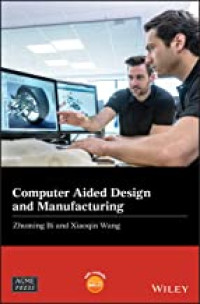Printed
Computer Aided Design and Manufacturing
1 Computers in Manufacturing
1.1 Introduction
1.2 Computer Aided Technologies (CATS)
1.3 CATS for Engineering Designs
1.4 Architecture of Computer Aided Systems
1.5 Computer Aided Technologies in Manufacturing
1.6 Limitation of the Existing Manufacturing Engineering Curriculum
1.7 Course Framework for Digital Manufacturing
1.8 Design of the CAD/CAM Course
Part I Computer Aided Design (CAD)
2 Computer Aided Geometric Modelling
2.1 Introduction
2.2 Basic Elements in Geometry
2.3 Representation of Shapes
2.4 Basic Modelling Methods:
2.5 Feature-Based Modelling with Design Intents
2.6 Interactive Feature-Based Modelling Using CAD Tools
3 Knowledge-Based Engineering
3.1 Generative Model in Engineering Design
3.2 Knowledge-Based Engineering
3.3 Parametric Modelling
3.4 Design Intents
3.5 Design Equations
3.6 Design Tables
3.7 Configuration as Part Properties
3.8 Design Tables in Assembly Models
3.9 Design Tables in Applications
4 Platform Technologies
4.1 Concurrent Engineering
4.2 Platform Technologies
4.3 Modularization
4.4 Product Platform
4.5 Product Variants Platform Technologies
4.6 Fundamentals to Platform Technologies
4.7 Design Procedure Product Platforms
4.8 Modularization Products
4.9 Platform Leveraging in CI
4.10 Evaluation Product Platforms
4.11 Computer Aided (CAD) Platform Technologies
4.12 Summary
4.13 Design Projects
5 Computer Aided Reverse Engineering
5.1 Introduction
5.2 RE as Design Methodology
5.3 RE Procedure
5.4 Digital Modelling
5.5 Hardware Systems for Data Acquisition
5.6 Software Systems for Data Processing
5.7 Typical Manufacturing Applications
5.9 RE-Trend of Development
5.10 Summary
5.11 Design Project
6 Computer Aided Machine Design
6.1 Introduction
6.2 General Functional Requirements (FRS) of Machines
6.3 Fundamentals of Machine Design
6.4 Kinematic Synthesis
6.5 Kinematics
6.6 Dynamic Modelling
6.7 Kinematic and Dynamics Modelling in Virtual Design
6.8 Summary
6.9 Design Project
Part II Computer Aided Manufacturing (CAM)
7 Group Technology and Cellular Manufacturing
7.1 Introduction
7.2 Manufacturing System and Components
7.3 Layouts of Manufacturing Systems
7.4 Group Technology (GT)
7.5 Cellular Manufacturing
7.6 Summary
7.7 Design Problems
8 Computer Aided Fixture Design
8.1 Introduction
8.2 Fixtures in Processes of Discrete Manufacturing
8.3 Fixtures and Jigs
8.4 Functional Requirements (FRS) of Fixtures
8.5 Fundamentals of Fixture Design
8.6 Types and Elements of Fixture Systems
8.7 Procedure of Fixture Design
8.8 Computer Aided Fixture Design
8.8.1 Fixture Design Library
8.8.2 Interference Detection
9 Computer Aided Manufacturing (CAM)
9.1 Introduction
9.2 Computer Aided Manufacturing (CAM)
9.3 Numerical Control (NC) Machine Tools
9.4 Machining Processes
9.5 Fundamentals of Machinin Programming
9.6 Computer Aided Manufacturing
9.7 Example of CAM Tool
9.8 Summary
9.9 Design Project
10 Simulation of Manufacturing Processes
10.1 Introduction
10.2 Manufacturing Processes
10.3 Shaping Processes
10.4 Manufacturing Processes – Designing and Planning
10.5 Procedure of Manufacturing Processes Planning
10.6 Casting Processes
10.7 Injection Moulding Processes
10.8 Mould Filling Analysis
10.9 Mould Flow Analysis Tool – SolidWork Plastics
11 Computer Aided Design of Tools, Dies, and Moulds
11.1 Introduction
11.2 Overview of Tools, Dies, and Industrial Moulds
11.3 Roles of TDM Industry in Manufacturing
11.4 General Requirements of TDM
11.5 Tooling for Injection Moulding
11.6 Design of Injection Moulding Systems
11.7 Computer Aided Mould Design
11.8 Computer Aided Mould Analysis
Part III System Integration
12 Digital Manufacturing (DM)
12.1 Introduction
12.2 Historical Development
12.3 Functional Requirements (FRs) of Digital Manufacturing
12.4 System Entropy and Complexity
12.5 System Architecture
12.6 Hardware Solutions
12.7 Big Data Analytics
12.8 Computer Simulation in DM
13 Direct and Additive Manufacturing
13.1 Introduction
13.2 Overview of Additive Manufacturing
13.3 Types of AM Techniques
13.4 AM Processes
13.5 Design for Additive Manufacturing (DfAM)
14 Designfor Sustainability (D4S)
14.1 Introduction
14.2 Sustainable Manufacturing
14.3 Drivers for Sustainability
14.4 Manufacturing and Sustainability
14.5 Metrics for Sustainable Manufacturing
14.6 Reconfigurability for Sustainability
14.7 Lean Production for Sustainability
14.8 Lifecycle Assessment (LCA) and Design for Sustainability
14.9 Conitnuous Improvement for Sustainability
14.10 Main Environmental Impact Factors
14.11Computer Aided Toos-SolidWorks Sustainability
Ketersediaan
Informasi Detail
- Judul Seri
-
-
- No. Panggil
-
658.5 ZHU c
- Penerbit
- New Jersey : Wiley-Blackwell., 2020
- Deskripsi Fisik
-
xxi, 617 hal. : ilus. ; 25 cm
- Bahasa
-
English
- ISBN/ISSN
-
978-1-119-53421-1
- Klasifikasi
-
658.5
- Tipe Isi
-
-
- Tipe Media
-
-
- Tipe Pembawa
-
-
- Edisi
-
1
- Subjek
- Info Detail Spesifik
-
-
- Pernyataan Tanggungjawab
-
-
Versi lain/terkait
Tidak tersedia versi lain
Lampiran Berkas
Komentar
Anda harus masuk sebelum memberikan komentar

 Karya Umum
Karya Umum  Filsafat
Filsafat  Agama
Agama  Ilmu-ilmu Sosial
Ilmu-ilmu Sosial  Bahasa
Bahasa  Ilmu-ilmu Murni
Ilmu-ilmu Murni  Ilmu-ilmu Terapan
Ilmu-ilmu Terapan  Kesenian, Hiburan, dan Olahraga
Kesenian, Hiburan, dan Olahraga  Kesusastraan
Kesusastraan  Geografi dan Sejarah
Geografi dan Sejarah